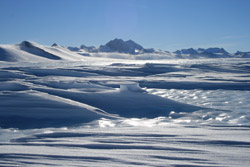What lies beneath – scientists discover giant trench under Antarctic Ice
Posted on 15 January 2014

Researchers from York worked with colleagues from Newcastle University, the University of Bristol’s Glaciology Centre, the British Antarctic Survey and the universities of Edinburgh and Exeter. They charted the Ellsworth Subglacial Highlands – an ancient mountain range buried beneath several kilometres of Antarctic ice - by combining data from satellites and ice-penetrating radars towed behind skidoos and on-board small aircraft.
The researchers spent three seasons investigating and mapping the region in West Antarctica, uncovering a massive subglacial valley up to three kilometres deep, more than 300 kilometres long and up to 25 kilometres across. In places, the floor of this valley is more than 2000 metres below sea level.
The mountain range and deep valley were carved millions of years ago by a small icefield similar to those of the present-day Antarctic Peninsula, or those of Arctic Canada and Alaska.
The team’s analysis has provided an unprecedented insight into the extent, thickness and behaviour of this ancient icefield, and the configuration and behaviour of the early West Antarctic Ice Sheet. The subglacial landscape shows where and how the West Antarctic Ice Sheet originated and grew. It also provides important clues about the size and shape of the ice sheet in West Antarctica in a warmer global climate.
The findings are published in the latest edition of the Geological Society of America Bulletin.
Dr David Rippin, senior lecturer in the Environment Department at York said: We almost discovered this trough by accident, when ice penetrating radar surveys we were carrying out in the region revealed both ends of this enormous valley. We didn’t have any radar data from its central portion, but when we looked at satellite imagery, we saw a clear manifestation of what lies beneath. This trough is so vast, that even though it is buried by several kilometres of ice, we can still see its impact on the ice surface from space.”
Notes to editors:
- The paper, The Ellsworth Subglacial Highlands: Inception and retreat of the West Antarctic Ice Sheet is available at: http://gsabulletin.gsapubs.org/content/126/1-2/3.abstract
- Find out more about the Environment Department: www.york.ac.uk/environment
Contact details
Keep up to date
Subscribe to news feeds
